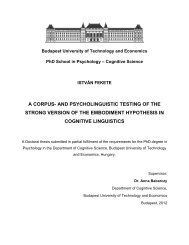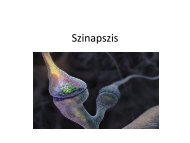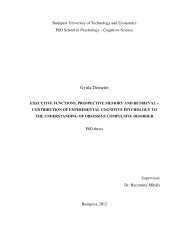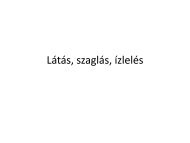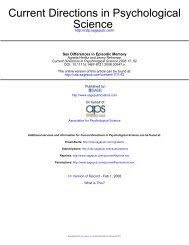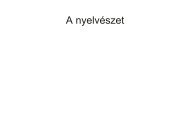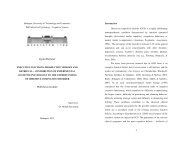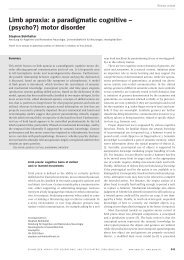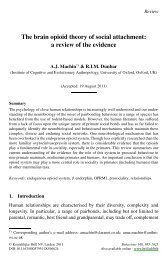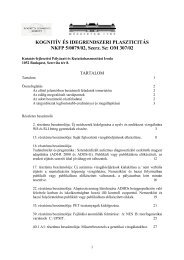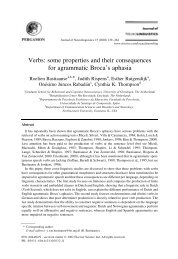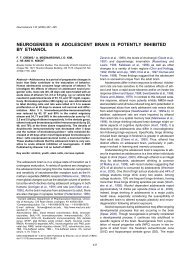Motoric response inhibition in finger movement and saccadic eye ...
Motoric response inhibition in finger movement and saccadic eye ...
Motoric response inhibition in finger movement and saccadic eye ...
You also want an ePaper? Increase the reach of your titles
YUMPU automatically turns print PDFs into web optimized ePapers that Google loves.
1062<br />
Table 1<br />
Mean motoric <strong>response</strong> latency (ms) ^ SEM a<br />
errors. Mean size of the amplitude difference between<br />
`correct <strong>and</strong> `<strong>in</strong>correct' NoGo trials was calculated across<br />
a 40 ms time <strong>in</strong>terval centred on maximum amplitude of the<br />
difference waveform. Mean values were measured relative<br />
to the average amplitude across a 250 ms <strong>in</strong>terval preced<strong>in</strong>g<br />
onset of the amplitude difference. Calculated difference<br />
values were evaluated statistically by repeated measures<br />
ANOVA, with with<strong>in</strong>-subject variables Movement Modality<br />
(®nger extension vs. <strong>eye</strong> <strong>movement</strong>), Error Size (large<br />
errors vs. small errors) <strong>and</strong> Electrode (FCz, Cz, Pz).<br />
2.4.4. Stimulus versus <strong>response</strong> aligned averag<strong>in</strong>g<br />
To exam<strong>in</strong>e whether component ERN is time-locked<br />
more closely to imperative stimulus onset or to onset of<br />
motoric <strong>response</strong> activity, stimulus aligned <strong>and</strong> motoric<br />
<strong>response</strong> aligned cortical <strong>response</strong> pro®les, averaged across<br />
`<strong>in</strong>correct' NoGo trials, were compared. Peak amplitude<br />
values of component ERN <strong>in</strong> the stimulus <strong>and</strong> <strong>response</strong><br />
aligned waveforms at mid-l<strong>in</strong>e electrode sites FCz, Cz <strong>and</strong><br />
Pz were exam<strong>in</strong>ed by repeated measures ANOVA, with<br />
Alignment (stimulus vs. <strong>response</strong> synchronized averag<strong>in</strong>g),<br />
Movement Modality (®nger vs. <strong>eye</strong> <strong>movement</strong>) <strong>and</strong> Electrode<br />
as with<strong>in</strong>-subject variables.<br />
For additional analysis, separate averages were<br />
constructed for `<strong>in</strong>correct' NoGo trials with early <strong>and</strong> late<br />
onset of motoric activity, respectively. It was hypothesized<br />
that if component ERN is time-locked more closely to the<br />
imperative stimulus, ERN onset <strong>and</strong> peak latency would be<br />
comparable across trials with early <strong>and</strong> late motoric<br />
<strong>response</strong> onset <strong>in</strong> the stimulus aligned averages. Component<br />
ERN would occur earlier on trials with late onset of motoric<br />
activity <strong>in</strong> the <strong>response</strong> locked averages. In contrast, if<br />
component ERN is time-locked more closely to motoric<br />
<strong>response</strong> onset, the ERN would appear at a comparable<br />
latency <strong>in</strong> the <strong>response</strong> synchronized averages <strong>and</strong> would<br />
occur earlier on trials with early onset of motoric activity <strong>in</strong><br />
the stimulus synchronized averages. <strong>Motoric</strong> <strong>response</strong><br />
latency was classi®ed as early or late when onset of motoric<br />
activity either preceded or followed median motoric<br />
<strong>response</strong> latency. For both <strong>movement</strong> modalities, median<br />
<strong>response</strong> latency was determ<strong>in</strong>ed from the set of motoric<br />
<strong>response</strong> latencies measured on `<strong>in</strong>correct' NoGo trials,<br />
across subjects <strong>and</strong> across right <strong>and</strong> left side <strong>movement</strong><br />
conditions. Statistical analysis of ERN latency values, by<br />
means of repeated measures ANOVA, was performed separately<br />
for stimulus <strong>and</strong> <strong>response</strong> synchronized averages.<br />
With<strong>in</strong>-subjects variables <strong>in</strong>cluded <strong>Motoric</strong> Response<br />
D. Van 't Ent, P. Apkarian / Cl<strong>in</strong>ical Neurophysiology 110 (1999) 1058±1072<br />
Right ®nger extension Left ®nger extension Saccades rightward Saccades leftward<br />
Go 179 ^ 23 167 ^ 29 211 ^ 22 209 ^ 25<br />
Incorrect NoGo 147 ^ 20 139 ^ 28 194 ^ 36 192 ^ 38<br />
a<br />
Mean motoric <strong>response</strong> latencies (^ st<strong>and</strong>ard error of the mean) on Go <strong>and</strong> `<strong>in</strong>correct' NoGo trials for each <strong>movement</strong> condition. Latency data for motoric<br />
activity on Go trials have been adapted from Van `t Ent <strong>and</strong> Apkarian (1998).<br />
Latency (early vs. late motoric <strong>response</strong> onset) <strong>and</strong> Movement<br />
Modality (®nger vs. <strong>eye</strong> <strong>movement</strong>).<br />
2.4.5. Lateralized read<strong>in</strong>ess potential (LRP)<br />
Motor related <strong>in</strong>ter-hemispheric amplitude lateralization<br />
was assessed by means of the lateralized read<strong>in</strong>ess potential<br />
(LRP) measure derived from stimulus synchronized ERPs<br />
(De Jong et al., 1988; Gratton et al., 1988). For statistical<br />
evaluation of <strong>in</strong>ter-hemispheric amplitude differences <strong>in</strong> the<br />
LRP, 3 contiguous 100 ms time w<strong>in</strong>dows were de®ned<br />
across a time <strong>in</strong>terval subtend<strong>in</strong>g from 100 ms follow<strong>in</strong>g<br />
stimulus offset (t ˆ 100 ms) to 400 ms follow<strong>in</strong>g stimulus<br />
offset (t ˆ 400 ms). Mean LRP values <strong>in</strong> each <strong>in</strong>dividual<br />
time w<strong>in</strong>dow were calculated for every subject <strong>and</strong> were<br />
exam<strong>in</strong>ed by means of Wilcoxon's test of paired differences.<br />
To account for multiple comparisons, signi®cant<br />
<strong>in</strong>ter-hemispheric asymmetry was assumed only when<br />
Wilcoxon's probability level was below P ˆ 0:01.<br />
3. Results<br />
3.1. <strong>Motoric</strong> <strong>response</strong> latency<br />
Onset latencies for motoric activity on Go trials <strong>and</strong> error<br />
<strong>response</strong>s on `<strong>in</strong>correct' NoGo trials, averaged across mean<br />
motoric <strong>response</strong> latencies for each <strong>in</strong>dividual subject, are<br />
listed <strong>in</strong> Table 1. Mean motoric <strong>response</strong> latency <strong>in</strong> the <strong>eye</strong><br />
<strong>movement</strong> tasks was signi®cantly longer than mean<br />
<strong>response</strong> latency <strong>in</strong> the ®nger extension tasks (variable<br />
Movement Modality; F…1; 9† ˆ52:41, P , 0:001). Furthermore,<br />
for both <strong>movement</strong> modalities, reaction times were<br />
shorter on `<strong>in</strong>correct' NoGo trials compared with Go trials<br />
(variable Go/NoGo: F…1; 9† ˆ18:50, P ˆ 0:002; <strong>in</strong>teraction<br />
Go/NoGo by Movement Modality: not signi®cant). No<br />
signi®cant differences were found for mean motoric<br />
<strong>response</strong> latency of right compared with left ®nger extensions<br />
or for mean <strong>response</strong> latency of rightward compared<br />
with leftward saccades.<br />
3.2. Event related potentials<br />
For Go <strong>and</strong> `<strong>in</strong>correct' NoGo averages, trials were<br />
<strong>in</strong>cluded when motoric <strong>response</strong> latency was with<strong>in</strong><br />
170:8 ^ 60:0 ms (latency range: 110.8±230.8 ms) for ®nger<br />
<strong>movement</strong> <strong>and</strong> with<strong>in</strong> 209:9 ^ 60:2 ms (latency range:<br />
149.7±270.1 ms) for <strong>saccadic</strong> <strong>eye</strong> <strong>movement</strong> (latency <strong>in</strong>tervals<br />
are derived from Van `t Ent <strong>and</strong> Apkarian, 1998). For



